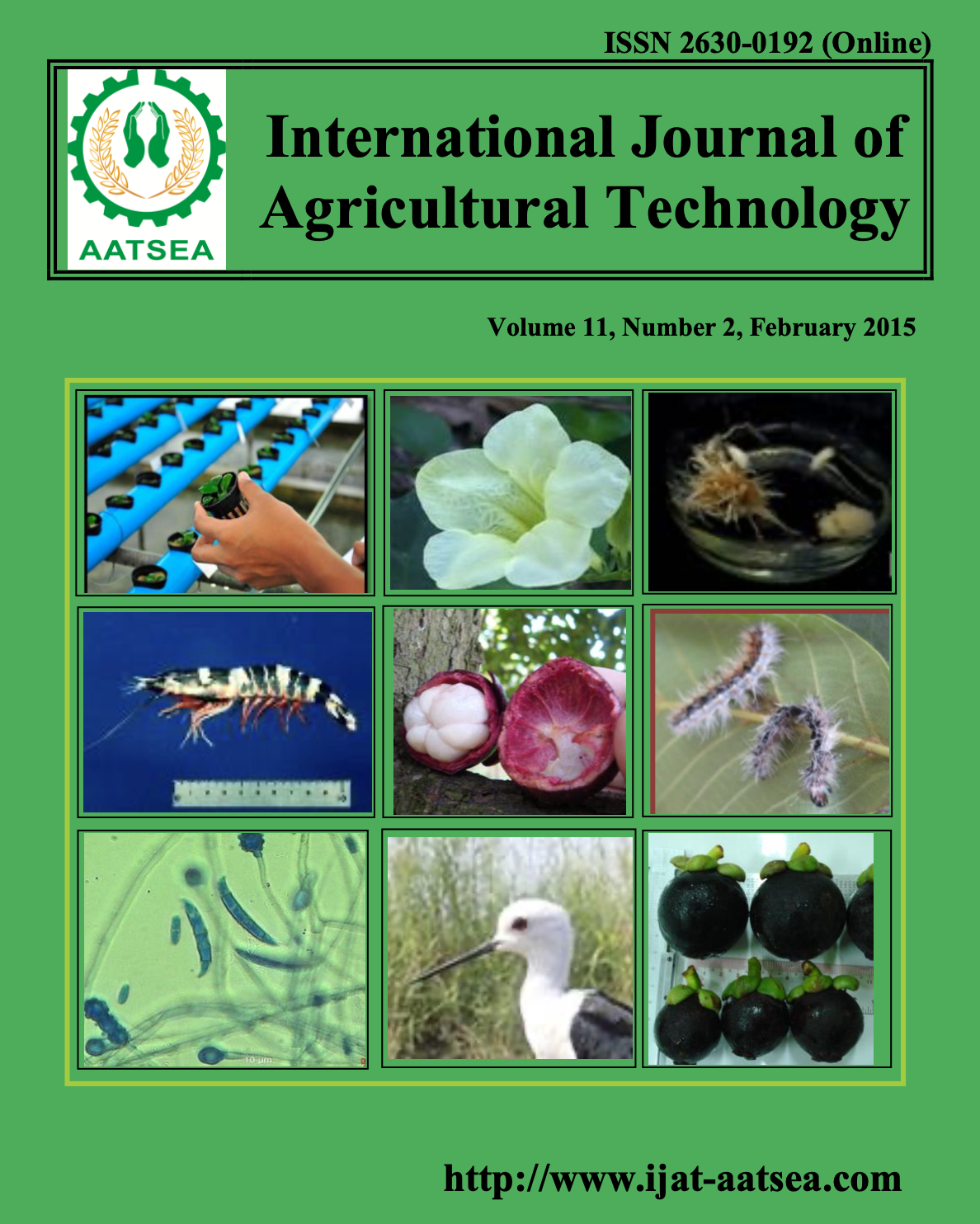Product development of sweet fermented rice (Khao-Mak) from Germinated Native Black Glutinous Rice
Main Article Content
Abstract
Product development of sweet fermented glutinous rice (Khao-Mak) of germinated native black glutinous rice was determined. Experiments were designed by using Randomized Complete Block Design (RCBD) with composed of 6 treatments. There are the ratio of glutinous rice and germinated native black glutinous rice 100:0, 80:20, 60:40, 40:60, 20:80 and 0:100, respectively. Sensory evaluation was determined by using 9-point hedonic scale. The results were found that most of consumer liked treatment 2 (glutinous rice : germinated native black glutinous rice; 80:20) with the highest score 8.10 (like) and significantly different from another treatments (p≤ 0.05). Then change in chemical characteristic (pH, total soluble solid, % alcohol and anthocyanin content) during fermentation were studied. The results exhibited that the similar trends was found in all of treatments. The physical, chemical and microbiological characteristic of final product were L* a* b* (12.44, 11.81 , 28.72), chemical composition; moister, ash, lipid, protein, fiber and carbohydrate content were 55.86, 0.29, 0.35, 3.11, 1.59 and 38.80 (%wb), respectively, total soluble solid (5.23 ◦ brix), pH (4.34), alcohol content (1.15 %), the total plate count (8.00 x103 cfu/g), yeast and molds count (5.30 x 103 cfu/g) and E. coli were in the community standard product of Thailand. Finally, the free radical scavenging capacity were assay by DPPH method shown that IC50 value had significantly higher three fold than control (59.70 ± 1.28 and 199.38 ± 2.59 mg/ml, respectively) (p≤ 0.05). In addition, g-aminobutyric acid (GABA) content were found 6.53 mg/100 g. In conclusion, the Khao-Mak from germinated black native glutinous rice from this research could be a new healthy product in the future.
Article Details

This work is licensed under a Creative Commons Attribution-NonCommercial-NoDerivatives 4.0 International License.
References
Banchuen, J., Thammarutwasik, P., Ooraikul, B., Wuttijumnong, P. and Sirivongpaisal, P. (2010). Increasing the bio-active compounds contents by optimizing the germination conditions of Southern Thai Brown Rice. Songklanakarin Journal of Science and Technology 32:219-230.
Chanta, S., Prathepha, P. and Jongdee, B. (2014). Nuances of traditional in utilization of rice landraces by a farming community in North-Eastern Thailand. Indian Journal of Traditional Knowledge 13:473-483.
De Llanos, R., Querol, A., Peman, J., Gobernato, M. and Fernandez-Espinar, M. T. (2006). Food and probiotics strains from the Saccharomyces cerevisiae species as a possible origin of human systemic infection. International Journal of Food Microbiology 110:286-290.
Karahara, H. (2004). Germinated brown rice. Department of Sciences of Functional Food. Shinshu University, Japan. pp 1-32.
Kong, J. M., Chia, L. S., Goh, K., Chia, T. F. and Brouillard, R. (2003). Analysis and biological activities of anthocyanins. Phytochemistry 64:923-933.
Lee, J., Durst, R. and Wrolstad, R. (2005). Determination of total monomeric anthocyanin pigment content of fruit juices, beverages, natural colorants, and wines by the pH differential method: collaborative study. Journal of AOAC International 88:1269-1278.
Lotong, N. (1992). Seed Inoculum and Their Production Technology. Bangkok, Thailand: Funny Plublishing.
Manosroi, A., Ruksiriwanich, W., Kietthankorn, B., Manosroi, W. and Manosroi, J. (2011). Relationship between biological activities and biological activities and bioactive compound in the fermented rice sap. Food research International 44:2757-2765.
Ministry of Industry (2003). Community product standard of sweet fermented glutinous rice. Document of CPS at 162/2003. Bangkok: Agro product standard office.
Okada, T., Sugishita, T., Murakami, T., Murai, H., Saikusa, T. and Horio, T. (2000). Effect of the defatted rice germ enrich with GABA for sleepless, depression, autonomic disorder by oral administration. Journal of the Japanese Society for Food Science and Technology 47:596-603.
Oki, T., Masuda, M., Kobayashi, M., Nishiba, Y., Furuta, S., Suda, I. and Sato, T. (2002). Polymeric procyanidins as radical-scavenging components in red hulled rice. Journal of Agricultural and Food Chemistry 50:7524-7529.
Panyanak, P., Suwanketnikom, S., Tonhang, S. and Siripoonwiwat, W. (2010). Correlations between seed characteristics, seed germination and -aminobutyric acid (GABA) content of 14 rice cultivars. Thai Journal of Botany 2:97-113.
Sangkitikomon, V., Tentumnou, T. and Rodchanasasod, A. (2008). Comparisions of total antioxidants of red rice, black rice and black sticky rice. Journal of nutrition 43:16-21.
Steel, R. G. D., Torrie, J. H. and Dickey, D. (1997). Principles and procedures of statistics. New York, USA: McGraw-Hill.
Tananuwong, K. and Tewaruth, W. (2010). Extraction and application of antioxidants from black glutinous rice. LWT-Food Science Technology 43:476-481.
Tanasupawat, S. and Komagata, K. (1995). Lactic acid bacteria in fermented foods in Thailand. World Journal of Microbiology and Biotechnology 11:253-256.
Tochampa, W., Jittrepotch, N., Kongbangkerd, T., Kraboun, K. and Rojsuntornkitti, K. (2011). The study of microwave heating time on chemical andmicrobiological properties and sensory evaluation in sweet fermented glutinous rice(Khao-Mark). International Food Research Journal 18:239-248.
Tongyai, A., Riebroy, S., Maneerat, S. Siriwong, N. and Chulakarungka, S. (2012). Changs in physicochemical and sensory characteristics during fermentation of Khaow-Maak from black glutinous rice. Bangkok: Kasetsart University.
Watts, B. M., Yumaki, C. L., Jeffery, L. E. and Elais, L. G. (1989). Basic sensory methods for food evalution. The International Development Research Centre, Ottawa, Canada. 159 pp.
Wongpiyachon, S. (1995). Utilization of rice for wine and whisky. (Master’s thesis). Kasetsart University, Bangkok, Thailand.
Zhu, K., Zhou, H. and Qian, H. (2006). Antioxidant and free radical scavenging activities of wheat germ protein hydrolysates (WGPH) prepared with catalase. Process Biochemistry 41:1296-1302.


